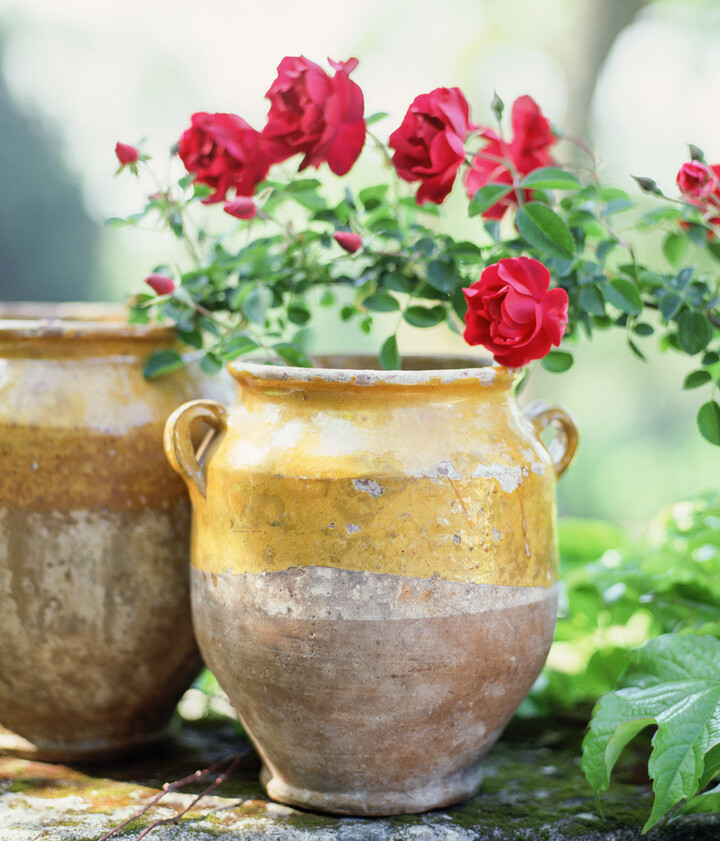Everything you need to know about buying and caring for a gorgeous find.

Adding antique elements to your garden—whether large-scale statues, understated planters, decorative fountains, or ornate benches—is an easy way to give your outdoor space a one-of-a-kind vibe. If you're a fan of vintage housewares, it's also helps your backyard serve as an extension of your home itself. But before you splurge on a historical treasure from a reputable dealer, make sure to take into account these five expert-approved tips.
Define Your Space
Before you start purchasing antiques for your garden, define your outdoor space as a collection of rooms; on a sprawling property this might include dedicated sections for your pool, outdoor entertaining and dining, a reading nook, and more, while a city dweller may be looking at cozier spaces dedicated to the fire pit, bistro table, and hammock. "Choose a single focal point that is central to the garden room and work outward from there," says Tracey Young of The Elemental Garden. "There will always be unfinished areas in the garden, and if you have one area you can go to—your own favorite spot—it will help restore you during the process."
Consider Your Climate
Few things will have a bigger impact on your antiques than the weather—wind and rain can weather stone while windstorms can endanger fragile pieces. "Soft limestone from France or Italy is a no-no in harsh winter climates unless you are willing to store the pieces inside over the winter," says Young. "In these climates, you should consider harder stone such as granite or American marble, metals such as copper and treated iron, and wood." Collectors in climates with extreme temperatures will have to put in extra work to protect their antiques during cold weather. "Fountains pose the biggest challenge," says Young, since they need several coats of sealant before they're installed and must be drained and covered every fall. "If you can't or won't take the necessary precautions for a fountain, don't buy one!" she says. "You will live to regret it."
Mirror Styles from Your House
While your landscaping and garden accents can speak to your own personal taste, they should also enhance your home's design. "All gardens should be designed to complement the style of the house and not the other way around," says Young. Each era has its own distinctive look: The clean, minimalist lines of Willy Guhl's mid-century modern pieces; the ornate, decorative elements of the Victorian era; transitional Art Deco gates from the 1920s and 1930s. Classical pieces—which include statues of animals and figures, stone finials, tiered fountains, and stone benches are especially versatile, says Young. "This style offers you the most flexibility and can be used with Colonials, Georgian Revivals, and Greek Revival houses," she says. "Most of the great gardens of the world are classical in nature."
You can also use a carefully curated collection of antiques to subtly alter your home's aesthetic. "More decorative architectural styles can always be toned down by reworking the gardens to be less decorative and more straightforward with complementary garden antiques," says Young. "But remember, the reverse does not hold. Avoid obvious clashes, such as using highly decorated Victorian pieces with a contemporary house."
Take a Closer Look
While you shouldn't expect to find antiques in mint condition, you do need to check for serious damage that could limit the piece's lifespan. "Authentic garden antiques will most likely all have some flaws or repairs because of their age," says Young. "Check the piece thoroughly for cracks, repairs, fissures, chips, and the like, and to see if repairs are solid or are starting to come apart. A deteriorating repair on a leg, for example, can become a fatal flaw if not tended to in advance."
The condition of the piece will also influence the price—so you should be prepared to factor in the cost (and stress) of repairs if you think a tag is too good to be true. "Asses your budget," says Young, "and focus on buying one great piece rather than multiple inferior pieces." When collecting, says Barbara Israel of Barbara Israel Garden Antiques, to look for signatures or marks that indicate a piece was made by an artisan rather than in a factory. These will also impact the final price.
Care for Your Antiques Properly
If you want your pieces to last, it's essential that you protect them from moisture, freezing temperatures, and cracks. "Everything needs to be cared for, even if it means doing nothing but inspecting it twice a year for deteriorating condition," says Young. Pieces made from soft limestone need to be sealed before they're placed outside, and anything made from stone needs to be mounted on concrete—not placed directly on dirt. "All types of stone, natural or man-made, will wick moisture up through the bottom or legs and then the water will freeze during the winter," says Young. Urns and planters that fill with water and freeze during the winter will crack, so your fall chores will include emptying them, clearing the drain holes, and covering them for the winter to guarantee they don't fill with water; another alternative is a custom liner that allows for expansion and contraction while the planters are still full. Any pieces you can't move inside should be protected with a custom canvas—not plastic—cover. "The power of the winter sun magnified by the plastic can wipe out patina that has taken years to accumulate," says Young.